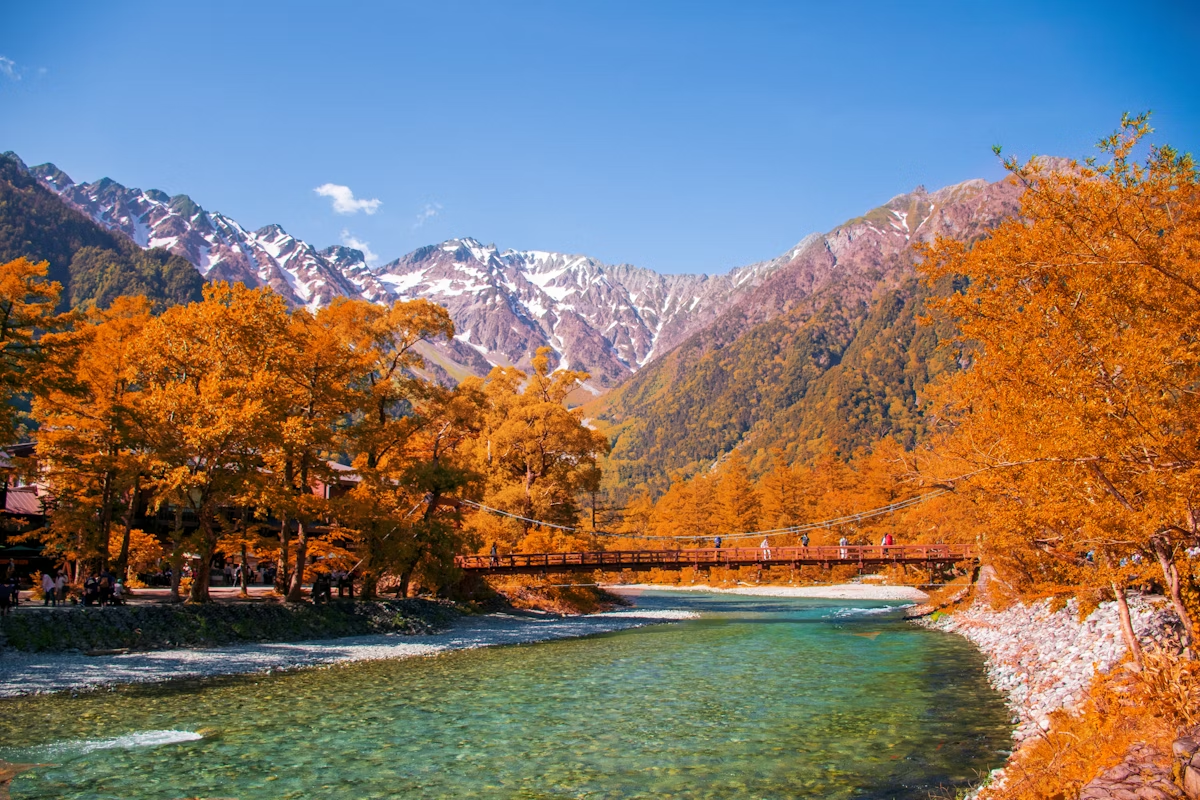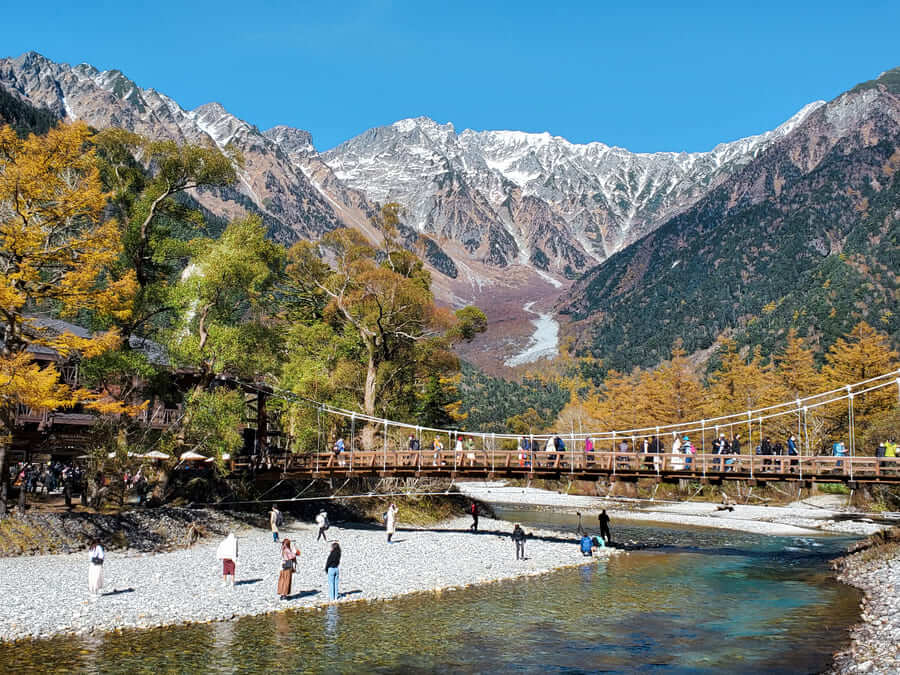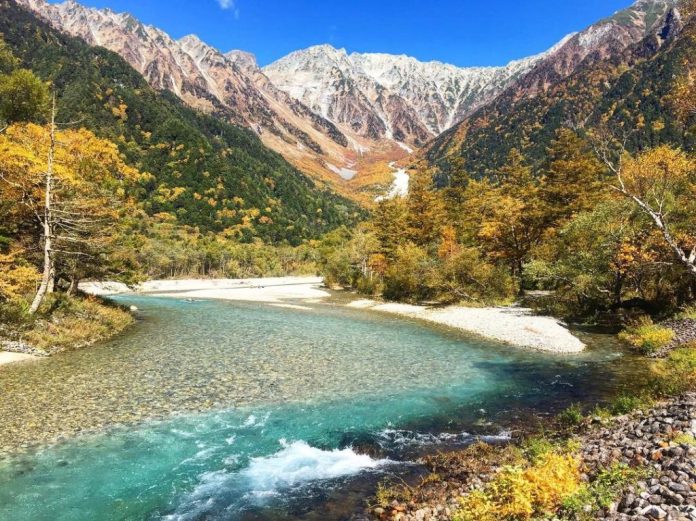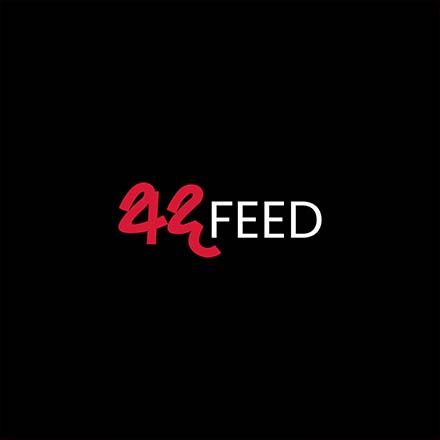Nestled in the Japanese Alps at 1,500m elevation, the autumn resort town of Kamikochi is an idyllic, car-free getaway with cool, crisp mountain air, riverside hiking trails and an abundance of Japanese snow monkeys.
With a projected 35 million foreign visitors flocking to Japan this year autumn, Kamikochi stands out as a serene retreat, offering a refreshing escape from the hustle and bustle of the country’s more tourist-laden spots. Tucked away in the majestic Japanese Alps at an elevation of 1,500 meters, this autumn seasonal resort town is renowned for its pristine natural beauty and tranquil atmosphere.
Here, you won’t find the usual commercial establishments; there are no fast-food chains like McDonald’s or Starbucks, nor are there private homes or year-round residents. Instead, Kamikochi serves as a sanctuary from the oppressive summer and autumn heat that blankets much of Japan, particularly in the hot months of July and August. Its reputation as a picturesque destination peaks in autumn, when the foliage transforms into a vibrant palette of colors, with the most breathtaking hues occurring in October.
My own introduction to Kamikochi was immediate and enchanting, though my two teenage sons, Leo and James, initially expressed discontent over the shared shower facilities at our hotel. Their grumbling soon faded when I assured them that our planned itinerary for our three-day, two-night stay revolved solely around hiking, dining, and relaxation. “No museums or temples?” James cheered, relieved at the prospect of a vacation from our previous excursions, which had included a plethora of cultural sites. Kamikochi promised to be a holiday from our holiday in autumn, with its simple, rustic accommodations and a smattering of hotels, restaurants, and shops lining the banks of the serene Azusa River.

The quest for untouched natural landscapes, free from the grasp of mass tourism, is not a new endeavor. As far back as 1896, the English missionary, mountaineer, and conservationist Reverend Walter Weston lamented the impact of foreign tourists who hurried through Japan, barely pausing to absorb the country’s rich cultural tapestry. He echoed the sentiments of a Japanese writer who criticized visitors for their fleeting impressions, suggesting that true understanding of a place required deeper engagement than a superficial glance.
Weston, in his writings and lectures, played a significant role in popularizing the term “Japanese Alps,” thereby casting a spotlight on the region that would eventually become Kamikochi. The town gained further notoriety in 1927 when Ryunosuke Akutagawa, one of Japan’s most celebrated authors, released his novel “Kappa,” set in this idyllic locale. This literary work resonated with readers and cemented Kamikochi’s status as a favored holiday destination for Japanese tourists.
The establishment of Chūbu-Sangaku National Park in 1934, which encompasses Kamikochi and ten of Japan’s twenty-one peaks exceeding 3,000 meters, only added to its allure. The area garnered acclaim as “the most beautiful valley in Japan,” drawing comparisons to California’s famed Yosemite National Park.
Amidst the rising discourse surrounding overtourism and increasing visitor numbers across Japan, I approached Kamikochi with the hope that it would offer a peaceful respite from the bustling cities we had recently explored, including Kyoto, Osaka, and Tokyo. Our trip had taken us through some of the country’s most popular destinations, and I yearned for the tranquility that Kamikochi seemed to promise.
In Kanazawa, a nearby city, I had the opportunity to chat with our volunteer guide, Michiko Kitaguchi, who was introduced to us through the Kanazawa Goodwill Guide Association. She shared her insights about Kamikochi, noting that in Chinese, the name translates to “a place where the god descends.” She described her favorite season in Kamikochi as autumn, when the valley bursts into a spectacular display of colors. “I am a Kamikochi lover who goes there every year to feel the energy of nature,” she said.
Her description of the flowing river, the mountains of Hodaka adorned with autumn foliage, and the golden larch trees by the riverside painted a vivid picture of the beauty that awaited us.

www.alpico.co.jp
Kamikochi has been committed to environmental preservation since 1975, when private cars and motorcycles were banned to combat the rising traffic and tourist volume that threatened to disrupt its serenity. The efforts to maintain the area’s natural beauty began even earlier, with logging bans introduced in 1875. Additional regulations were enacted in 1909 to protect alpine vegetation, and by 1916, the region was designated as Japan’s first “protection forest.”
In the 1960s, the Kamikochi Beautification Association was founded to tackle littering and promote responsible tourist behavior. A cap on the number of accommodations was set at seventeen, the same number that exists today, alongside two campsites, with no Airbnb options available.
This commitment to preservation lends Kamikochi an egalitarian feel; nearly everyone arrives via bus. Visitors who attempt to drive must park at least thirty minutes away and take a shuttle bus to reach the resort area. There are also hiking and taxi options, but the majority opt for the convenience of the bus service. Since 1994, a hybrid bus route has connected Kamikochi with Takayama and Matsumoto, the latter renowned for its striking 16th-century castle. In 2005, tour buses were also prohibited, further enhancing the peaceful atmosphere of the area.
Upon our arrival, I was grateful that we had chosen a hotel conveniently located near the bus terminal: the Nishi-itoya Mountain Lodge, which offers both private rooms and hostel-style bunk beds. Other lodging options, such as the historic Tokusawa Inn established in 1885, require a hike of one to two hours from the terminal, with luggage in tow. As we crossed the Kappa Bridge, named after Akutagawa’s novel, we found ourselves weaving through a crowd of tourists wielding selfie sticks. It became evident that Kamikochi was not as secluded as I had hoped, though our visit coincided with a bustling Saturday.
Determined to make the most of our time in this natural wonderland, we devised a plan to embark on three easy hikes during our stay, one for each day, while steering clear of the steep, strenuous treks that characterize peaks like Mt. Jonen, Mt. Chogatake, and Mt. Oku-Hotakadake. The national park boasts an impressive forty mountain summits exceeding 2,400 meters, attracting avid climbers from all over the globe.
Our first hike led us to Myojin Pond, where I felt a familiar travel high that comes with discovering breathtaking landscapes. Along the way, we encountered several playful Japanese snow monkeys, who added to the enchanting atmosphere as we strolled alongside the crystal-clear river. The temperature hovered at a pleasant 18 degrees Celsius, a welcome relief from the stifling heat we had endured in Takayama. Kamikochi is also a notable destination for birdwatching, and the melodious calls of the Japanese bush warbler echoed through the trees, creating a delightful symphony of nature.
In 2023, Kamikochi welcomed approximately 1.3 million visitors, with most of them being Japanese nationals. While this figure is substantial, it pales in comparison to the staggering numbers flocking to Mt. Fuji, which typically attracts over 100 million visitors annually. Kamikochi, along with Mt. Fuji, is recognized by Japan’s Cultural Affairs Agency as both a Special Place of Scenic Beauty and a Special Natural Monument, underscoring its significance within the country’s diverse landscapes.
To our delight, we learned that many visitors to Kamikochi are day-trippers who tend to depart by late afternoon, allowing us to enjoy the natural beauty without the encroachment of too many tourists. After the initial influx we encountered at Kappa Bridge on our first afternoon, the later hours revealed a much quieter scene.

Curious about the local workforce, I struck up a conversation with a friendly restaurant server at our hotel. When I inquired about her living situation, she informed me that she resided in a dormitory for workers just behind the hotel. She explained that Kamikochi operates seasonally, welcoming guests from April 27 to November 15, during which time it transforms into a vibrant hub of activity. Outside of these dates, the area is nearly deserted, and workers like her migrate to other regions for employment.
As we spoke, she pulled out her phone and shared some breathtaking photographs from a recent long hike she had taken to Taisho Pond, a picturesque body of water bordered by the snow-capped peak of Mt. Yakedake, which erupted in 1915, creating the stunning pond by damming the Azusa River. “This is why I’m happy here,” she said, flipping through the striking images.
Our final hike brought us to Taisho Pond, and the sight was indeed awe-inspiring. The rugged mountains adorned with wisps of snow resembled a fantasy realm, reminiscent of the imaginative landscapes crafted by Akutagawa, who tragically took his own life at the young age of 35 shortly after publishing “Kappa.” The novel’s protagonist seeks peace in Kamikochi in autumn, only to discover a peculiar race of diminutive, sumo-wrestling water spirits known as kappas.
Although we encountered no mythical creatures, my sons were less than thrilled with the nudity often associated with the onsen (natural hot springs). Regardless, we found solace in the fact that Japan’s extensive conservation initiatives have effectively preserved Kamikochi’s untamed beauty, which captivated earlier explorers like Weston and Akutagawa. There are few places left where visitors can indulge in a car-free holiday amidst nature during autumn, where the only sounds are birds chirping, and the only sightings are of playful snow monkeys.
As we spent our days hiking and exploring, the beauty of autumn began to unfold around us. The vibrant reds, oranges, and yellows painted the landscape in a breathtaking display, reminding us of the ephemeral nature of the season. Autumn in Kamikochi is nothing short of magical, with every corner revealing a new perspective.




